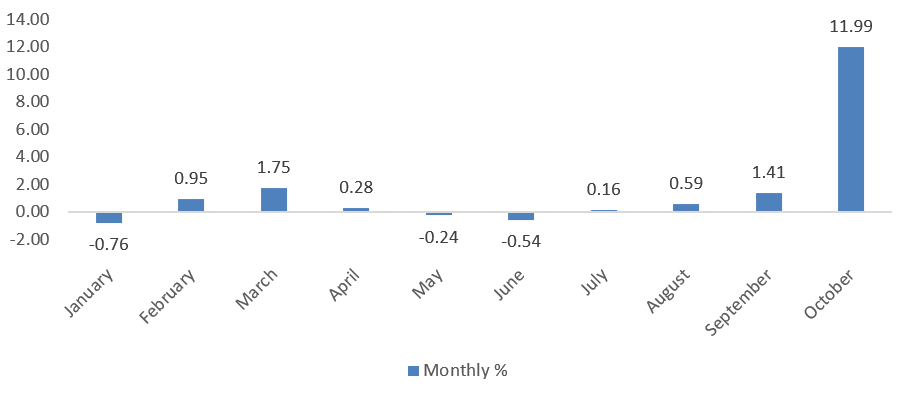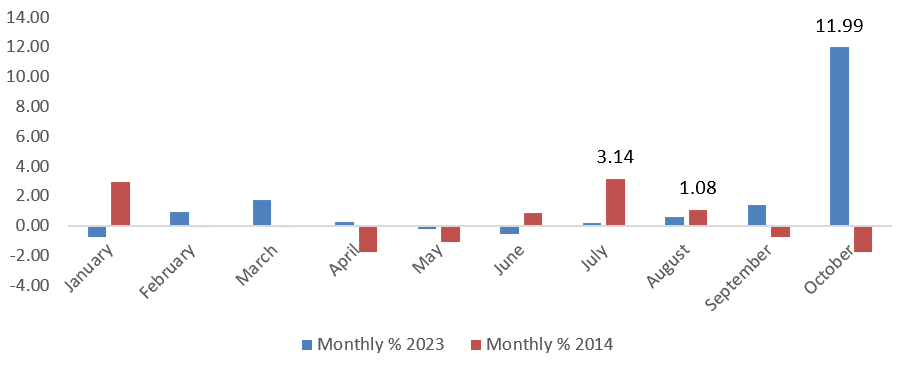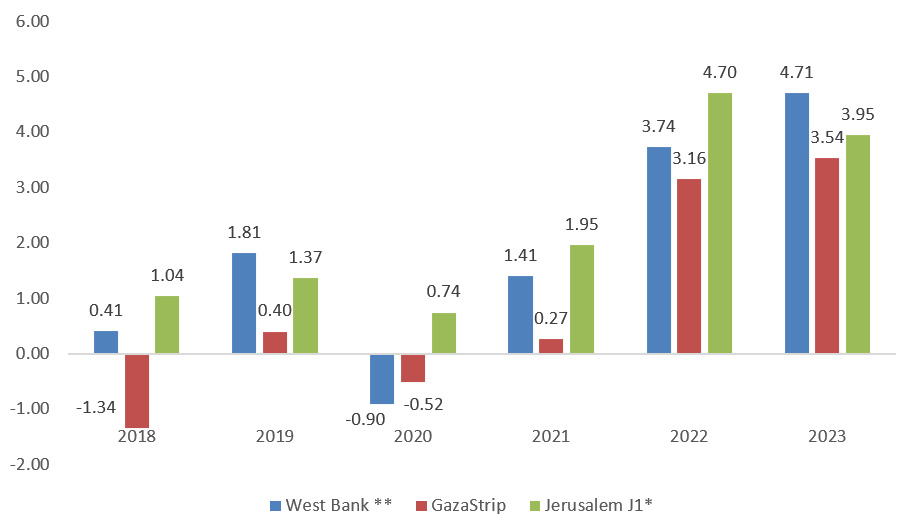Palestinian Central Bureau of Statistics (PCBS)
Impact of Israeli Occupation Aggression on
Consumer Prices in Gaza Strip
An unprecedented increase in consumer prices that Gaza Strip
never witnessed before
Consumer prices increased by 12% during the first month of Israeli aggression against Gaza Strip
Prices of consumer goods in Gaza Strip sharply increased by 12% in October 2023 compared to September 2023. Israel's aggression against Gaza Strip as of October 7th, 2023 and the imposition of a complete siege, closure of crossings and cutting off water, fuel and gas supplies had the greatest impact that led to the high rise of consumer goods, especially food, as well as fuel prices, due to scarce quantities and not being allowed into Gaza Strip in addition to the increase of transport expenses from northern Gaza to central and southern Gaza, in light of the continued displacement of householdsin Gaza Strip.
A sharp increase in food prices and a shortage in the availability of food in the market
Prices of food and non-alcoholic beverages recorded a sharp increase of 10% during the Israeli aggression. Also, mineral water prices increased by 74%, as the price of one mineral water bottle (1.5 liters) increased from NIS 2 to NIS 4 during the war on Gaza Strip, with being limited in the markets and the use of non-potable water. In addition, dried vegetables increased by 47%; dry onions are sold 5 NIS/kg. Moreover, prices of fresh vegetables increased by 32%, where tomatoes are sold for 7 NIS/kg, cucumbers are sold for 4 NIS/kg, zucchinis for 6 NIS/kg, eggplants for 3 NIS/kg, chili pepper for 12 NIS/kg, and bell pepper for 9NIS/kg. Furthermore, potato prices increased by 30% to be sold for 4 NIS/kg, while fresh fruit prices increased by 27% despite their scarce availability from the market and out of the stock, where apples are sold for 7 NIS/kg and lemons for 5 NIS/kg.
A decline in Palestinian households' purchase power in Gaza Strip by 11%
The purchase power of the Palestinian households in Gaza Strip dropped by 11% during the Israeli aggression against Gaza Strip compared to September 2023, due to the increase in prices in Gaza's markets and limited availability due to being out of stock. Hence, households now cannot access shopping centers, due to the total closure of borders and crossings and not allowing aids access into Gaza Strip, which, in return, leads to a decrease in the monthly quantities purchased by the households in Gaza Strip. According to the household consumption and expenditure data, households in Gaza Strip need an average of 56 kg of bread and grains monthly, in addition to 35 kg of flour, and 17 kg of meat and poultry of which 10 kg are fresh poultry. They also need 22 kg of fresh fruit and 39 kg of fresh vegetables, 9 kg of dried and canned beans and vegetables and 12 kg of potatoes per month. In addition to 13 liters of cold beverages "including mineral and soft water and juices". Thus, and in light of the rise in prices and the decline in the purchase power of money, the households have not been able to buy this amount as they used to, which would be life threatening for households' lives in Gaza Strip.
In any normal situation, the households in Gaza Strip spend 33% of their average income on food and non-alcoholic beverages. In other words, the household in Gaza Strip needs NIS 330 of every NIS 1,000 to buy their needs of food and drinks. Hence, now with these high prices of food and non-alcoholic beverages that increased by 21% in November 2023 from the base year, the household needs NIS1,206 to buy the same quantities of food and drinks.
Flour is running out of Gaza markets, bakeries are shutting down their business in light of Israeli aggression against Gaza Strip.
High prices were not only limited to fresh goods, the high prices were also for all goods that require fuel and water, where the prices of bread increased by 2%, as 3 kg of bread loaves are sold for eight shekels. Accordingly, the rise of bread prices came as a result of the high prices of flour and its scarce availability in markets. Knowingly, the price of wheat increased by 16%, where the price of flour bag of 50 kg reached 150 shekels during the first three weeks of the Israeli aggression. It is worth mentioning that flour bag of 50 kg was sold 91 shekels just before October 7th, 2023. The situation will worsen even more during the coming days due to scarce availability of flour in addition to the fact that many bakeries are shutting down due to being targeted and bombarded, as well as the lack of fuel and cutting off water supply.
Electricity cuts have worsened the situation in Gaza Strip.
The increase of prices also hit all goods that need refrigerators in light of powercutsin Gaza Strip, where prices of chicken increased by 5.50%, where chickens are sold for 17 NIS/kg. While the households in Gaza Strip stopped buying fresh meat and fish for never being on the market. Also, prices of eggs increased by 23%, where the carton of eggs weigh 2 kg sold for 18 NIS during the first three weeks of the Israeli aggression on Gaza Strip, after being sold for 13 NIS couple of days before the aggression.
Vegetable oil prices also increased by 5% and rice prices by 8%, where corn oil of 3 liters is sold for 34 NIS, and 1 kg of rice for 9 NIS. It is worth mentioning that the value of Gaza's imports are amounted to USD 89 million during October, of which USD 35 million was foods (61%), most of it was rice, flour, oils, meat and mineral water.
Since October 7th, 2023, the number of aid trucks that entered Gaza Strip carrying food, medicine and water is 569 trucks. Yet and unfortunately, they are not even enough to cover the needs of the households in Gaza and are not distributed fairly. The number of trucks per day that entered Gaza Strip in the time before the war was 500 trucks per day, on average of 15,000 trucks per month. So, what have entered Gaza during the Israeli aggression is one third % of what the market needs. It should be noted that 80% of the population of Gaza Strip receives in-kind and cash assistance from various NGOs working in Gaza Strip according to the data of UN human organizations. Furthermore, poverty was about 53% among individuals in Gaza Strip according to consumption patterns during 2017, while 34% of Gaza Strip's people are suffering from extreme poverty, and about 54% individuals in Gaza Strip had a monthly income below the extreme poverty line, all of this made the situation even worse.
Fuel is a black market
With a complete siege on Gaza Strip and with no permission to allow fuel into Gaza through the crossings, diesel prices increased by 129% and gasoline prices by 118%. Knowingly,1 liter of diesel or gasoline is now sold for NIS 20 where it was sold for NIS 6.49 and NIS6.79, respectively, as it is now like a rare commodity in the black market. Hence, Gaza Strip needs about USD 322 thousand of gasoline, about USD 429 thousand of diesel and about USD 164 thousand of gas on average for October to cover the market's need of fuel.
A sharp increase in transport expenses as the households are being forced to move from northern Gaza to the center and south of Gaza
The Israeli aggression against Gaza Strip has adversely affected transport expenses, as many households are displaced from the north to the center or the south of Gaza Strip. Thus, transport expenses increased by 179%, whereas each passenger travel expenses was NIS4, yet now it costs NIS100 for one person to move from the north to the center of Gaza Strip, and it used to cost 8 NIS to travel from the north to the south of Gaza Strip, but now it costs NIS 150 per one person.
Moreover, the households in Gaza Strip spend 8% of their average income on transport, 10% of their average income on the housing, and 7% of their average income on fuel "for home and cars use". As transport prices increased by 125% during the Israeli aggression on Gaza more than what it was in the base year, where now one household needs NIS 2252 to spend on fuel and transportation expenses instead of NIS 1,000.
High prices that Gaza Strip has never witnessed before
Gaza Strip has never witnessed before such an increase in prices, even in the July-August war 2014, goods prices have not increased that much. The consumer price index in July 2014 increased by 3% compared to June. It also continued to increase by 1% during August, 2014 compared to July; however, prices returned back to normal in the following months and after the Israeli aggression on Gaza in 2014 that lasted for 51 days.
The following graph illustrates the overall direction for the monthly change percentages of the consumer price index in Gaza Strip during January – October, 2013

The following graph illustrates a comparison of the overall direction for the monthly change percentages of the consumer price index in Gaza Strip during January – October, for the years 2014, 2023

Even in the last three years along with COVID-19 Pandemic and the Russian-Ukrainian War and their repercussions on the Palestinian market, where prices were high but reasonable and considered normal when compared with prices in the West Bank and Jerusalem J1.
The following graph illustrates the overall direction for the annual change percentages of the consumer price index by region for the years 2018-2023

Note: Data of 2023 is not completed up to this date, whereas data for the first ten months of 2023 are completed.
*Data represent those parts of Jerusalem Governorate that were forcibly annexed by Israeli occupation in 1967.
** Data don’t include those parts of Jerusalem Governorate that were forcibly annexed by the Israeli Occupation in 1967
 عربي
عربي